The old senior living model offers a safe place, serves three meals, and provides some social activities. That’s not cutting it anymore.
Today’s seniors are showing up with bigger expectations. They want autonomy, connection, and purpose. They want technology that helps, not frustrates.
Meanwhile, families are asking harder questions. They want better communication, more transparency, and real proof that their loved ones are thriving.
Operators are under pressure to deliver all this while juggling staffing shortages, rising costs, and fierce market competition.
The future of senior living will belong to the communities that stop clinging to “what’s worked” and start leaning into what’s next.
In this blog, we’re breaking down five emerging senior living trends in 2025.
1. Technology Integration for Better Resident Care
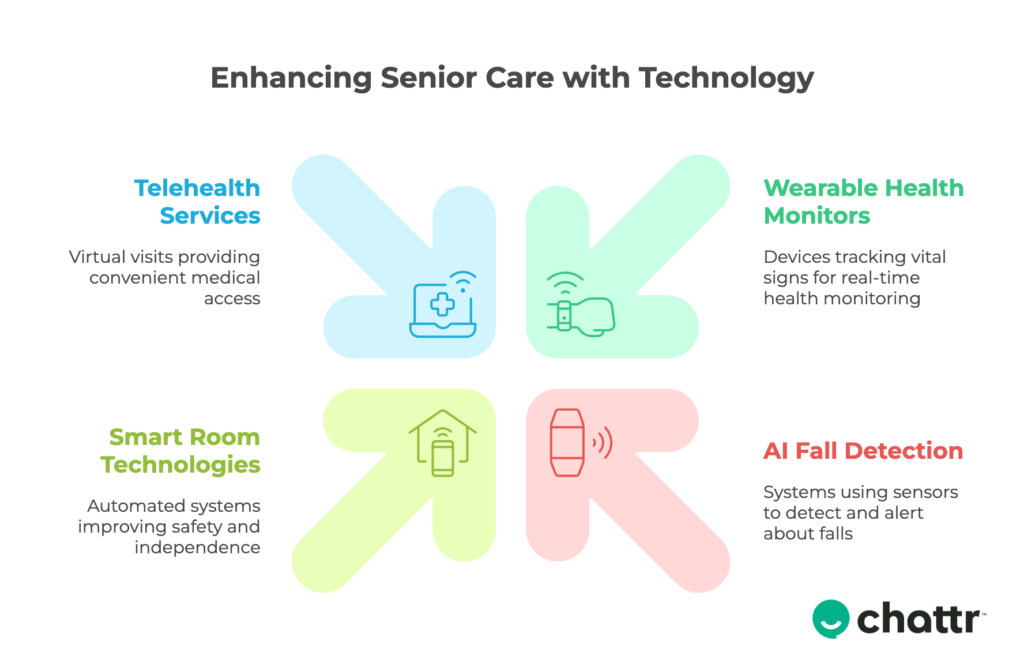
Senior living communities have started embracing technology to enhance resident care.
This integration of smart tech is about providing safer, more personalized, and efficient care for our aging population.
→ Wearable Health Monitors
Wearable devices like the Apple Watch Series 8 and the Oura Ring Gen 3 are becoming staples in senior care. These devices monitor vital signs such as heart rate, sleep patterns, and activity levels, allowing caregivers to track residents’ health in real-time.
That’s peace of mind for families and staff.
→ AI-Powered Fall Detection
Falls are a significant concern in senior living. AI-powered systems like the Kami Fall Detect Camera utilize advanced sensors to monitor residents’ movements and detect falls with high accuracy.
Caregivers get an alert right away, so they can jump in fast and reduce the risk of serious injury.
→ Smart Room Technologies
Smart rooms equipped with motion sensors, voice-activated controls, and automated lighting are enhancing the living experience for seniors.
These technologies not only improve safety by preventing accidents but also promote independence by allowing residents to control their environment easily.
→ Telehealth Services
Getting to a doctor’s office can be tough for seniors. That’s why telehealth has become a must-have.
Residents can hop on a virtual visit from their room, saving time and energy while still getting expert care. It’s especially useful for regular check-ins or managing chronic conditions.
2. Prioritizing Mental Health and Social Well-Being in Senior Living
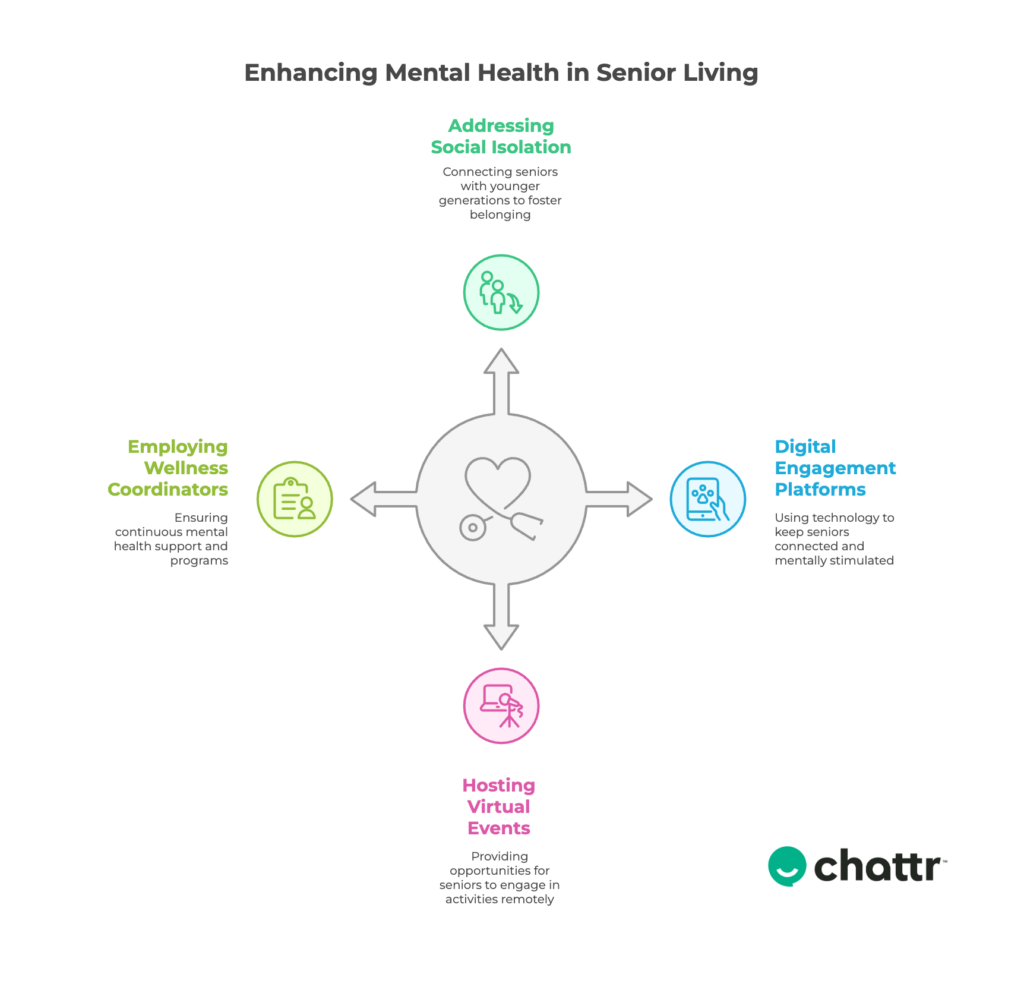
In today’s senior living communities, emotional health is finally getting the attention it deserves.
→ Addressing Social Isolation
Loneliness among older adults is a significant concern.
According to the World Health Organization, social isolation can lead to serious health risks, including stroke, anxiety, dementia, and even early death.
One smart approach? Pairing senior communities with schools or colleges so residents can connect with younger generations. It’s about creating that sense of belonging and making sure no one feels left out or forgotten.
→ Implementing Digital Engagement Platforms
Technology has become a lifeline for keeping people connected.
Digital engagement platforms enable residents to participate in virtual events, connect with family and friends, and access a variety of online activities.
These tools help reduce feelings of isolation and keep residents mentally stimulated.
→ Hosting Virtual Events
Virtual fitness classes. Online book clubs. Streaming concerts.
These events provide opportunities for residents to engage with others and pursue their interests, regardless of physical limitations. Organizers can also rely on TV playout software to seamlessly manage and broadcast these virtual experiences to a wider audience.
→ Employing Wellness Coordinators
Wellness coordinators are integral to promoting mental health in senior living communities.
They organize programs focused on emotional well-being, facilitate support groups, and provide resources for residents to manage stress and anxiety. Their presence ensures that mental health is a continuous priority within the community.
3. Workforce Innovation and AI-Powered Staffing
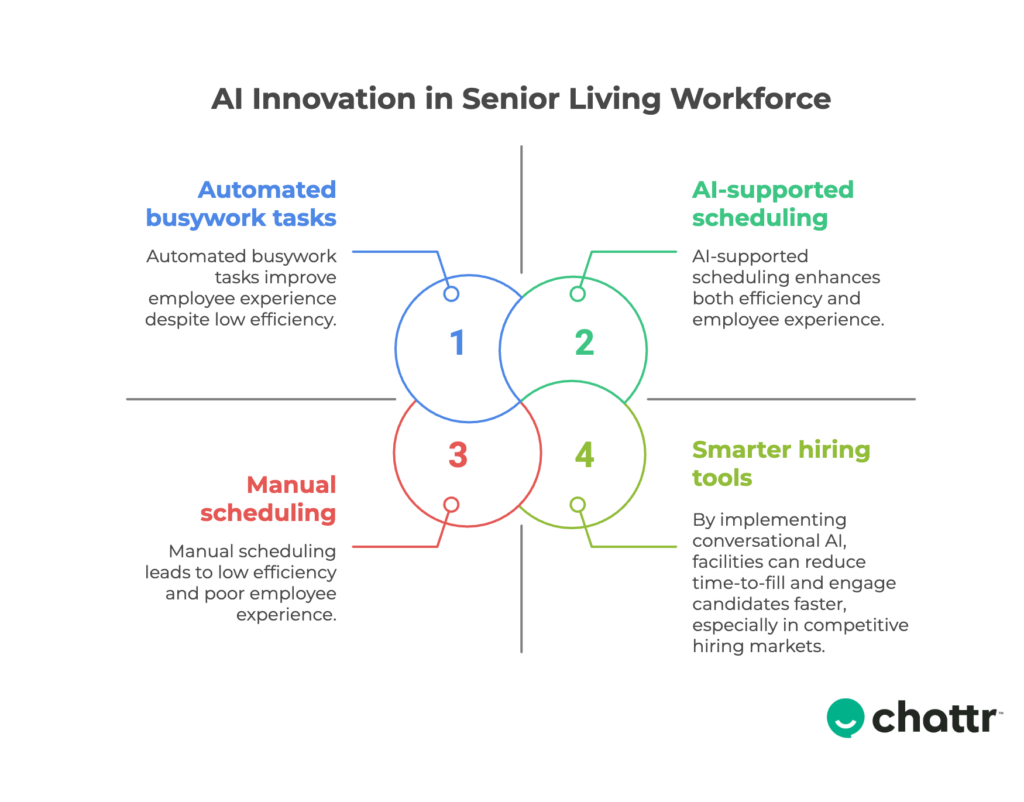
Every senior living leader we talk to says the same thing: staffing is tough right now.
Labor shortages are real. Turnover feels like it’s always ticking up. And at the same time, residents and their families are expecting more skilled, attentive care.
This is where innovation comes in.
→ AI-Supported Scheduling That Works
No one likes juggling shift schedules by hand. AI-powered scheduling tools are making a huge difference.
These systems help balance workloads, fill open shifts, and reduce last-minute scrambles. Staff members know when they’re working, managers save hours of admin time, and the whole team runs smoother.
→ Automating the Busywork
Smart tech isn’t here to replace the human touch but to cut out the busywork.
With the right tools, teams can automate tasks like time tracking, training reminders, and documentation. That gives caregivers more time to focus on what really matters: the residents.
→ Better Tools for Staff Training
Great care starts with great training.
More senior living communities are investing in modern learning platforms. These tools make it easier to deliver training on everything from clinical care to communication and empathy. And because they’re often mobile-friendly, staff can learn on the go, when it works best for them.
When staff feel supported and set up for success, residents feel the difference.
This is one of the most important shifts in senior living trends— recognizing that the resident experience is directly tied to the employee experience.
→ Smarter Hiring Tools Are Changing the Game
A big part of improving workforce experience comes down to hiring. Operators need to bring in the right people faster, without dragging teams through weeks of screening and back-and-forth.
This is where Chattr helps.
With AI-driven screening, automated interview scheduling, and real-time candidate updates, Chattr helps senior living operators speed up hiring, cut down on busywork, and focus on building strong, reliable teams.
By implementing conversational AI, facilities can reduce time-to-fill and engage candidates faster, especially in competitive hiring markets.
When you have the right staff in place, everything improves — resident care, team morale, and business results.
If you’re curious to try them out, feel free to book a demo right away.
4. Customizable Living and Lifestyle Experiences
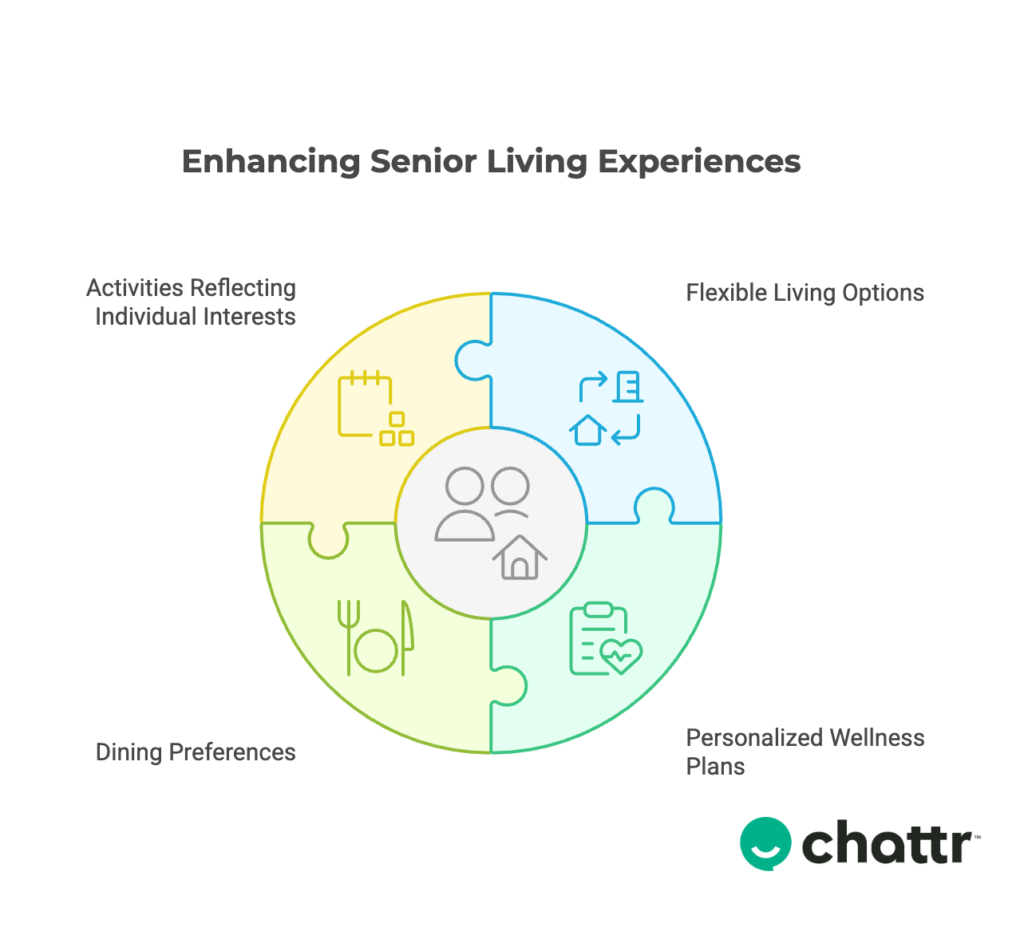
Seniors today don’t want a cookie-cutter experience. They want choice. They want freedom. And they want their daily life to reflect who they are, not just what’s “offered.”
More senior living communities are realizing this and stepping up.
→ Flexible Living Options
Many communities now offer flexible living setups.
Residents can choose apartment layouts, furniture styles, and even how much daily assistance they want. This shift gives seniors more control over their space and helps them feel at home.
→ Personalized Wellness Plans
Health is personal. That’s why many senior living communities are offering a la carte wellness services.
Maybe one resident wants weekly yoga. Another might prefer strength training or meditation classes. By letting people pick what works for them, these communities create more meaningful wellness experiences.
→ Dining That Fits Real Preferences
Gone are the days of rigid meal plans. One of the most important senior living trends is to give residents multiple meal choices, flexible dining hours, and menus that cater to personal tastes or dietary needs.
→ Activities That Reflect the Individual
Not everyone wants bingo or crafts.
Some residents want art workshops, technology classes, or outdoor adventures.
Others want book clubs or volunteer opportunities. The best communities listen and build activity calendars that reflect what residents care about.
5. Pay Transparency and Equity
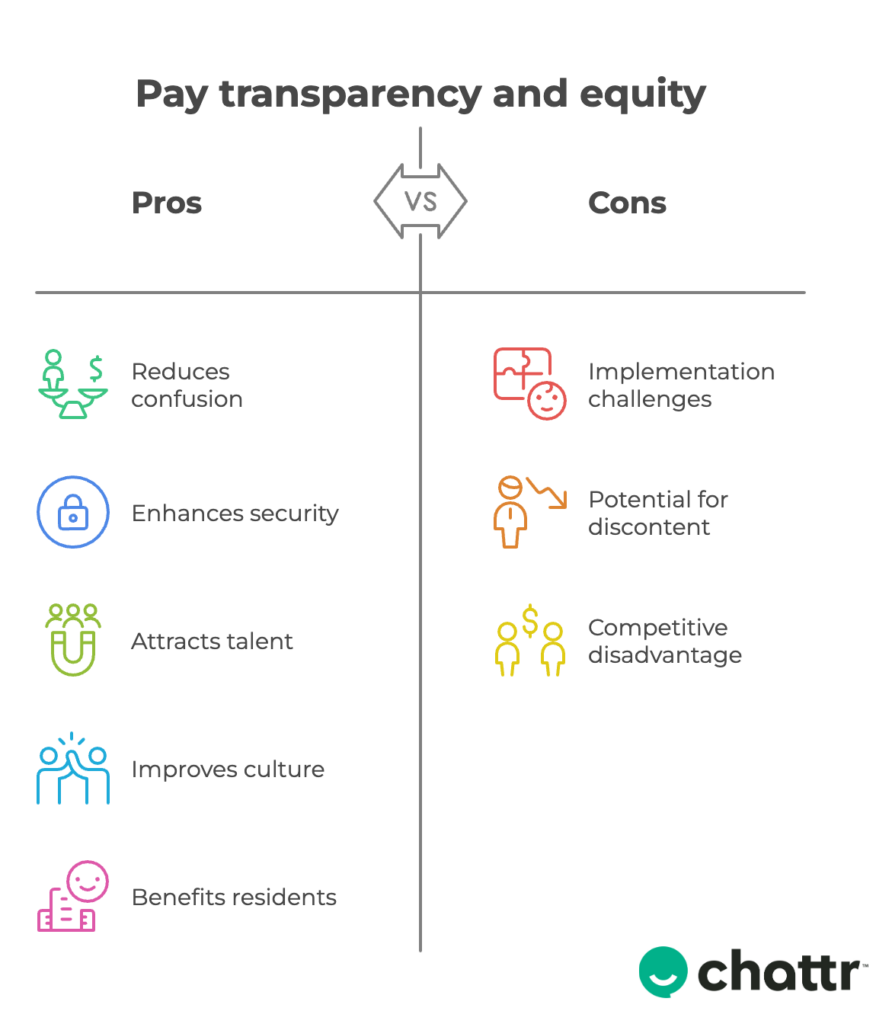
More senior living communities are starting to share clear pay scales with their staff. This helps remove confusion and cuts down on frustration. Workers know what to expect, what growth looks like, and how raises work.
When pay is clear, staff feel more secure. They don’t have to wonder if someone else is getting a better deal for the same work.
→ Closing Pay Gaps
Fairness goes beyond transparency. Communities are reviewing their pay structures to spot and fix gaps. This includes looking at roles, gender, experience, and responsibilities.
It’s part of running a workplace that attracts and keeps good people. And when staff are treated fairly, residents benefit too.
→ A Better Culture for Everyone
At the end of the day, fair pay supports a better work culture. Staff trust leadership more. They stick around longer. They focus on their work, not on comparing paychecks behind the scenes.
Senior living trends are moving toward more open, fair, and thoughtful compensation practices. The communities that lead the way on this will have an edge, not just with staff, but with residents and families who are watching how these places treat their people.
Final Thoughts
Senior living is changing fast, but the goal stays the same: give seniors the care, respect, and quality of life they deserve.
To stay ahead, operators need to do more than follow these senior living trends. They need to build workplaces and communities that adapt to new regulations, embrace fair pay, and stay bias-free.
The future belongs to those who combine innovation with heart.